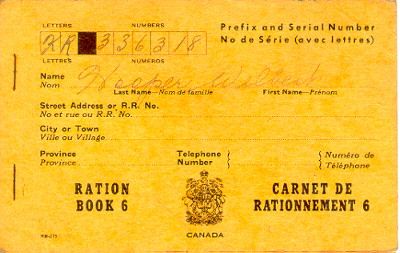? Day 161 of Vintage 365 ?
In this era of Walmart Super Centers, football field sized Costco stores, and seemingly endless sources online from which to purchase groceries with the mere click of a mouse, it can be easy to forget that once, just a few decades ago, our foremothers and fathers had to contend with the wartime necessarily of food rationing.
Canada was one of the first non-European (ally) countries to enter the second world war, however we were spared rationing for a time. It wasn't until January 1942 when sugar was restricted to 12 ounces (340 grams) per person per week (as the war continued on, that quantity was later further slashed), that Canadians of the day got their first taste of war rationing.
Most people were happy to oblige with the new regulations, knowing full well that the foods they gave up (and/or ate less) of could then go towards the troops overseas. Yet, one has to imagine that it was unpleasant at times to go without some of the most basic culinary and household staples for several years in a row.
As '42 wore on, other foods - such as coffee and tea ? made it onto the ration list. Within a matter of weeks of these two staples being rationed, coupon books began to be issued to Canadians from coast to coast (citizens filled out applications and were mailed ration books in the post, the first wave of which was sent out on August 31, 1942).
Perhaps foreseeing that the end of the war was still quite far in the future, the ration books contained coupons for other foods that had not yet even been restricted (such as butter, which, come December of that year, was added to the list of rationed foods, each person being allotted just 1/4 of a pound per week).

Over the course of the second world war, more than 11 million ration books (like the one pictured above, which comes by of the genealogy site Rootsweb) were issued to Canadians - who, like those in the UK and later the US, also saw dairy and meat rationing. At times however, stores were unable to supply citizens with the small allotments of rationed foods they were permitted to have, as supplies simply weren't available to the merchants.
While other day-to-day products (like gasoline, certain items of clothing, alcohol, even maple syrup!) were rationed as well, Canadians suffered less in a sense than those in Europe in this regard. That wasn't to say however, that Canadians were flush with extra clothing (not at all!) during the war years or that it was easy to get your hands on a bottle of whiskey, because it certainly wasn't.
Optimistic and determined by nature, many Canadians stretched their war rations by planting Victory Gardens, canning and preserving foods (interestingly, Canadians could apply for an addition "canning ration" of sugar), fishing, hunting for game, mending and restyling their existing clothes, and driving their cars far less (or not all) all in the name of the war effort.
These efforts, much like those of other allied nations, paid off in the end and helped the war effort immeasurably. Even though the war officially came to an end in 1945, rationing continued in Canada late in the 1940s (due in part to the fact that Canada was shipping a lot of food and other goods to help out in post-war Europe), with the last ration book being issued in September 1946.
On this date (June 10) in 1947, dairy was taken off of the ration list by the government and Canadians could once again enjoy larger quantities of foods like cheese, milk and ice cream once more. Having read this interestingly tidbit of history recently, I began to reflect on the fact that my grandparents experienced rationing, as did all Canadians of the day.
Which takes me back to my initial point. We have such an abundance of food at the ready today that it can be hard to imagine that just a few decades ago, the world was in such peril that staple foods - like meat, milk and sugar - needed to be strictly limited for the goal of achieving an allied victory.
I have a great of respect for those who made due, stretched their rations, grew their own gardens, and worked together as a nation to ensure that as many of our resources as possible could be rationed and put towards the war effort.
No matter how many aisles in the grocery store or how many restaurants dot the landscape, I try never to forget that part of the reason those shelves and restaurants can be so abundantly full is because people like my grandparents ? our grandparents ? lived through wartime rationing.
Just a little (un-rationed) food for thought the next time you pick up a double-double* on your way home from grocery shopping.
*A "double double" is a Canadian term for a coffee, often one purchased from a Tim Horton's doughnut shop, containing two creams and two sugars.

Source: http://www.chronicallyvintage.com/2011/06/look-back-at-canadian-ration-coupon.html
No comments:
Post a Comment